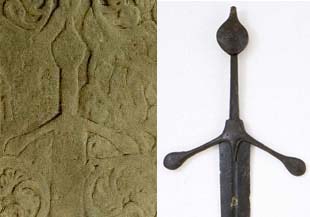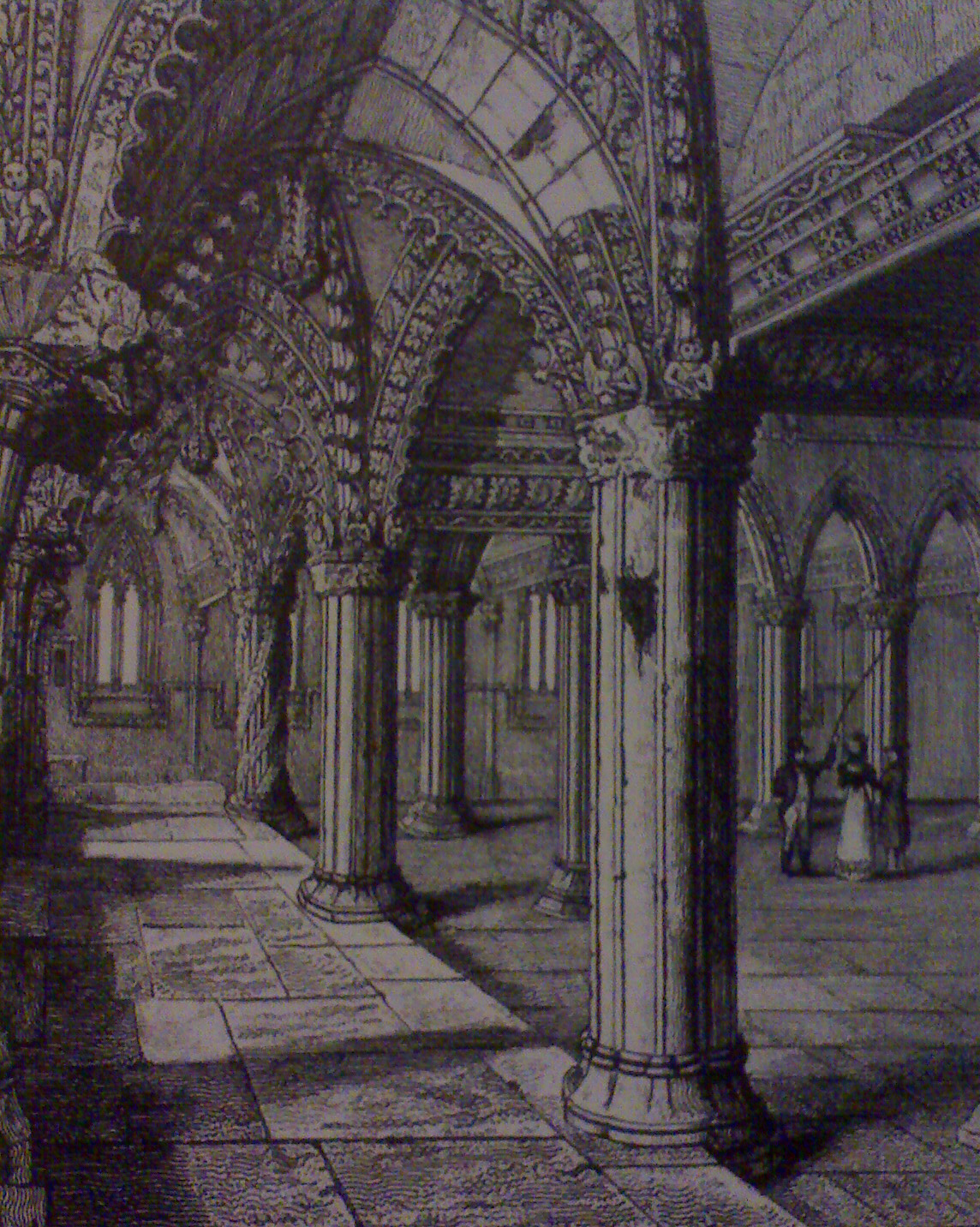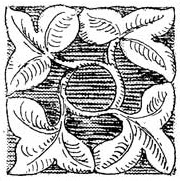Though entirely without substance, the notion that the medieval order of the Knights Templar hid and persisted somewhere in Scotland after their destruction in the early C14th is too far out of control to be dispatched in one post. It’s also been tackled quite thoroughly by others, notably Robert Cooper in his “Rosslyn Hoax?” and Mark Oxbrow in the less in-depth but rather more accessible “Rosslyn and the Grail“. I’ll focus on the claims surrounding some stone grave slabs at sites in Kilmartin and Kilmory Knap, both in the West Highlands of Scotland.

National heritage institution Historic Scotland describe Kilmory succinctly as “A small medieval chapel with a collection of typical West Highland grave slabs and some early medieval sculpture.” A bit of a “Mostly Harmless” entry, but hey, it’s accurate. This interpretation is not enough for the speculative historians, who propose it as evidence of a long-running hypothesis that the Knights Templar somehow survived disbandment and hid themselves in western Scotland (Argyll is the location usually given in the pseudohistorical “literature”). The Argyll connection was proposed by Baigent and Leigh of “Holy Blood, Holy Grail” fame, and as readers will know, once a claim is out there, it’s pretty tough to fully lay it to rest. Those carrying out some casual online research into the Templars or this area of Scotland will no doubt encounter the RosslynTemplars.org.uk site. This seems to be somewhat of a prototype for parts of Robert Cooper’s book, and hosts some useful images and musings. Being unfinished, however, and Cooper’s book (quite rightly) available in print only, it does not effectively separate fact from fiction and can appear ambiguous in places.
The lynch-pin, in fact, the only supposed evidence for the Templar connection is the idea that the grave marking slabs found there somehow represent Templar burials. A typical example is shown at the top of this item, and many more from Kilmory are to be seen on RosslynTemplars.org.uk. That site does recognise some flaws in the claims they relate, but ultimately still seem to “want to believe” that there must be something to the idea, and that Templars might indeed have been buried there. Of course, they’re working backwards – trying to fit the evidence to the claim and doing Baigent and Leigh’s work for them in the process. A more critical approach is needed.
For those unfamiliar with both the graveslabs of the West Highlands and the history of the Templars (i.e. most people!) this seems quite plausible on the face of it. But are these slabs so unusual? Do they really bear Templar symbolism and even depict Knights of the order? Well, this blog isn’t called the “BS Historian” for nothing. Let’s take a realistic run through the Baigent and Leigh checklist of “Templar” features…
Templar Slabs?
Let’s not mess about. They don’t look anything like Knights Templar, or any other crusading knight, for that matter. As an artefact type, the slabs themselves (an example from elsewhere is pictured above) constitute nothing more or less than evidence of a warrior elite with ties in all three areas – fighting men who lent or sold their skills and weaponry to anyone worthy or wealthy enough, from Irish chieftains to Robert the Bruce himself. In fact slabs like this are quite common not just in Argyll, the claimed refuge of the last Templars, but across the West Highlands and Isles of Scotland. Thanks to the Galloglass branches of the families in question, they also have direct parallels in Ireland, typically show more heavily armoured men. One theory is that the original West Highland warriors, being more reliant upon their wooden galleys for transport (see below), eschewed easily corroded and difficult to maintain mail armour in favour of their distinctive long quilted aketon/cotuns, possibly faced with deer hide. Of course it’s also possible that the reverse is true, with mail worn under the aketon, the Galloglass being the ones abandoning their outer armour (for some reason). The other de rigeur features of such figures (although not all slabs have all features) are a rather pointy type of bascinet , a simple spear, and usually, a distinctively Scottish style of single-handed sword.

Grave slab from Islay
The intention of all of this material depiction was the same – to display power, prestige, and wealth. In the case of the Galloglass kindreds, this was hard-earned by mercenary soldiering. Much of the military equipment shown tallies with that listed in the Bruce’s Arming Act of 1318 – the warriors may have been demonstrating that they were so equipped, and then some! But none of it, not one feature, has any connection whatever to the Knights Templar. In light of this, Andrew Sinclair’s claim that a figure at Kilmartin is that of a “crusader” is odd. As armed and armoured men go, he could not look less like a crusading knight, let alone a Templar specifically. See the movie “Kingdom of Heaven” for a good idea of what they ought to look like, or some of the images on this excellent page (about the great helm of the period):


Crusaders c1285 (left) and effigy drawings of REAL Knights Templar (right)
All wear typical head-to-toe mail and sleeveless surcoats.
Nothing like the West Highland warrior slabs.
Templar Ships?
Some slabs, not just those near Argyll (see above), also include a depiction of a sailing vessel. The Templars did indeed use wooden medieval galleys of this sort – they even had their own shipwrights. So is this a true and reliable Tempar symbol? Unlikely. These are rather more likely to be depictions of West Highland galleys, even more vital to life in the watery world of the coastal and isles Gael than to the globetrotting Templar. There is also an element of the Scandinavian influence here again – these vessels were not so different in construction and function to the Viking longships still being built in the Norse homelands at the time. But they were more visually impressive, being owned and used by those at the other end of the social scale to your average logboat paddler. Kindreds or clans with West Highland connections like Clan Donald even came to use the galley in their coats of arms. For those with hereditary or battle-won prestige and finances, the grand galley, like the other slab features, was a symbol of their power and influence – an attempt to “take it with you” in death that the typical Christian burial ritual, with its proscription against grave goods, couldn’t sacrifice. It may actually be a hang-over from pagan days.

A typical West Highland galley – but from a named Gaelic tomb
in the Western Isles, not the Argyll area…
Templar Swords?
RosslynTemplars pose the question of whether the ubiquitous and disctinctive sword design seen on the slabs might be a uniquely Templar weapon. I can answer this by saying that there is no evidence at all that these swords were ever used by Templars, and every indication that they were a Scando-Gaelic Scottish design. This page mentions the Baigent and Leigh claim that graveslabs bearing a sword like that seen at Kilmartin, did indeed once mark Templar graves. This is clearly nonsense when one examines the dozens of West Highland, Isles, and even East Highland slabs that feature the same type of Gaelic single-handed or hand-and-a-half sword in some capacity. These weapons all feature a swept guard with swollen tips, protruding central “langets” along the blade, and either lobated or “tea-cosy” type Viking style pommel, or a later rounded type with protruding tang enclosure (as seen two links back). The blade is usually a pan-European design classified by sword historian Ewart Oakeshott as Type XII – a wide but tapering 3/4 fullered blade, whose heyday was the 13th and 14th centuries – within the period of both Templar (1100-1307) and our warriors (c1300-1400). It’s not possible to establish a closer date for either carved depictions, or for the several examples of these swords that exist today in museum collections, but we know from these real swords that the depictions are accurate and Gaelic in origin, because no weapons of this complete design (or “halflang”, as some arms and armour scholars call it) have ever been found outside Scotland. Further, many elements of the hilt were retained or adapted in the later and much more well-known two-handed “claymore” of the 16th Century, with its quatrefoil (rather than swollen) terminals. A tell-tale typological sign is that the later pommel on the “halflang” is identical to that on the earlier of the claymores, before a globe pommel was adopted, which was in turn (along with many cut-down blades) retained in the basket-hilted “claymore” of later years. These earliest swords are therefore part of an traceable tradition of Scottish swordmaking. Any refugee Templar choosing to be buried under a representation of such a weapon, must have wholly embraced the culture of his adopted land in order to forsake the conventional cross-hilted weapon of his crusading days. Or to quote Eddie Murphy, deep deep deep undercover. So much so, that we wouldn’t actually be able to tell him from his native counterpart. Which makes a nonsense of the original claim.

One of the Kilmory slab swords (left) and one of several surviving “halflang”
swords recovered in Scotland and Ireland (this one is now in Glasgow)
Templar Crosses?
The other vaguely plausible claim about these slabs at Kilmartin is that one of them (far left in this linked image) bears a cross pattee – the symbol of the Knights Templar. A conclusion of Templar origins must first ignore the classic single-handed Scottish sword, as discussed above. Granted, the cross within the circle somewhat resembles the cross pattee, one application of which was as a Templar symbol. However, it’s not actually a cross at all (though may have been intended to serve as one in this context). Have a look at the below images, especially another slab from elsewhere in the Highlands which depicts another textbook West Highland warrior, with the same so-called “pattee” cross at his feet. Compare the supposed “Templar” example… In fact, it is a cross-of-arcs – a common early (“Celtic”) Christian, Anglo-Saxon, and Scandinavian design. See “Early Medieval Sculpture in the West Highlands and Islands” for some examples of this, especially page 128. They are found not just in this area, but across Scotland and England. This makes sense given the mixed cultural background of the warriors in question, but none at all in terms of any supposed Templar connection. Though the Kilmartin and Kilmory crosses may be contemporary with the Templars, the style of cross pre-dates them. It didn’t originate with them, and wasn’t exclusive to them even in their heyday.



Kilmartin cross claimed as Templar (left) compared to West Highland (middle) and English Cumbrian (right) equivalents
But wait a second, there is another, quite strikingly “pattee” cross at Kilmory. There’s no denying that it matches pretty closely. Again though, one only has to start looking for similar crosses in the medieval Gaelic world, and we start to see them everywhere. For example in Ireland, carved into older, pagan stones in an attempt to assert religious control. Clearly these cannot all be Templar in origin. In fact the style of cross is a popular and recurring form of the famous Christian “brand logo”, one of many chosen for subtle variations in their meaning, now lost, or simply for stylistic or regional reasons.
The same goes for this example, with the extra snag that the piece of stone bearing this supposed Templar temple marker was found in modern times, more than ten miles from the chapel. The chances of it being carved to mark out Kilmory chapel as a Templar one are therefore slim (never mind the issue of just how incognito these secret Templars could be with the medieval equivalent of a flashing neon sign over their door…
And how about this slab below? Is this a Templar cross?

Nope. This is the slab of a priest who was dead and buried on the opposite coast to Argyll – in Aberdeen – more than 100 years before the Templars were even disbanded (remember, the claim here is that the remaining Templars took refuge in Scotland after their early C14th disbandment). The folks at RosslynTemplars.org.uk must be aware of other crosses similar to the croix pattee that are certainly not, because they show an example of a consecration cross here. The bracelet design on this slab is another, the sword denoting another career warrior of note in the area. Other funerary art of the time and region includes plant-like designs and wheel-like crosses like the “escarbuncle” to be seen on the grave slab of William St Clair (now in Rosslyn Chapel). Of course the St Clair slab is also claimed to be Templar, despite his family giving evidence against the Templars at a 1309 trial. The design of cross to be included on any given English or Scottish slab of the 12th-15th centuries was down to personal or family preference, and each had subtly different meanings. The Templars themselves used a variety of cross designs beside the pattee or St John’s cross, and even if the crosses at Kilmory were perfect matches for a croix pattee, we could still not say with any certainty that this denoted a Templar grave.
Masonic Set-Square?
There is only one Argyllshire slab that features all of the items on the Baigent and Leigh Templar Spotter’s checklist. The galley, the armed figure, the sword, the cross and “floriate” designs we have already covered in this article, as being typically medieval Gaelic features found across a wide area. The “masonic set square” is the last of these. It is a difficult feature to interpret, and seems to resemble a set-square only inasmuch as any right-angled design. But, even assuming it does represent a set-square, we are talking 300 years before the Freemasons were even established. There is, in addition, no historic connection between the Knights Templar and the Freemasons – only what the latter call “traditional histories” – myths, to you and I. See Robert Cooper’s “Rosslyn Hoax” for an excellent debunking of this connection. Prior to Freemasonry, which formed from earlier guilds of stonemasons, a set-square depicted in stone meant some connection to an actual craftsman. Given that at least one graveslab from the Isles features a dedication to three craftsmen apparently valued by the Lords of the Isles, the appearance of such a feature should certainly not result in a default conclusion of “Knight Templar!”
In conclusion then, to accept the above as evidence of French Templar knights in the Gaelic West Highlands is to deny an historically documented warrior culture. Baigent and Leigh claim that Argyll was chosen as the new HQ of the now secret order, because it was sparsely populated and remote. More modern-day snobbery I’m afraid. In reality medieval Argyll was a thriving sea port in an age when over-land travel was difficult, but wooden sailing ships afforded fast and reliable access to this, and other coastal towns. Another claim is that it was the Bruce himself who afforded safe haven to the Knights Templar because of their assistance to him, notably at the pivotal Battle of Bannockburn where a mysterious host of knights is said to have arrived at the eleventh hour to save the day. This too, is rubbish, with no mention in the contemporary sources. The “small folk” referred to latterly would have been lightly armed camp followers fighting on foot, not mounted knights. Their arrival on the field either persuaded the enemy that a reserve force was engaging and they must retreat. The very idea of a fanatical religious order of knights fighting with the excommunicated Bruce is inherently unlikely. Ironically though, West Highland warriors and Islemen; the men really buried under the slabs mentioned above, were among Bruce’s host that day. And the Knights Templar do have history elsewhere in Scotland; just not after their disbandment as claimed. It’s strange that instead of taking an interest in real history, some prefer to weave romantic fantasy.

 Never mind the “code” – what about the mullet?
Never mind the “code” – what about the mullet?























